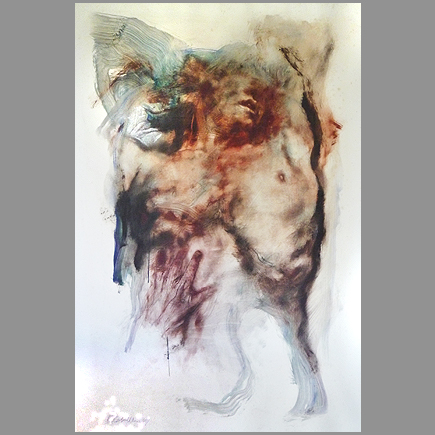Luis Caballero (1943-1995) Bogotá, Colombia. Luis Caballero Holguín, one of the most significant Latin American painters of the second half of the twentieth century, considered his homosexuality a fundamental component of his artistic expression. He frequently described semen as his most important artistic medium.
For the last twenty-five years of Caballero's life, the nude male figure was his only subject. In his turbulent, large-scale compositions, he expressed the interaction of sensuality with aggression and even death.
Early Years and Education
Born on August 27, 1943 in Bogotá, Colombia, Caballero was raised in a strict and conservative Catholic household. However, from an early age, he found consolation in sacred images, and he devised powerful erotic fantasies about the beautiful figures of Christ and male saints displayed in the churches of Bogotá. In the 1970s, recollections of these childhood musings helped to inspire his mature style and subject matter.
From 1961 to 1962, Caballero studied art at the Universidad de los Andes, Bogotá. Among the teachers there, he was most strongly influenced by the Spanish-born artist Juan Antonio Roda (1921-2003), who had moved to Colombia in 1955. In the Delirium of Dead Nuns, an etching series of 1974, and other psychologically complex depictions of female figures, Roda equated the repression of sexuality with death and martyrdom.
From 1963 to 1964, Caballero completed his formal artistic training in Paris at the Académie de la Grande Chaumière. In Paris, Caballero felt liberated by the widespread acceptance of homosexuality and the pervasive mood of sexual freedom. In this environment, he began indulging his seemingly inexhaustible sexual appetites with many anonymous sexual encounters, as he would do for most of the rest of his life.
Career in Colombia, 1965-1969
Returning to Bogotá in 1965, he had difficulty supporting himself as an artist. In 1967, he accepted a position, which he held until 1969, as instructor of painting and drawing at the Universidad de los Andes. Producing art work at a furious pace during this time, Caballero experimented with many of the styles then popular in North America and Europe.
Thus, he imitated the styles of various prominent international painters, including Richard Hamilton, Allen Jones, Willem DeKooning, and Francis Bacon, among many others. Of these, the only artist who would exert an enduring influence was Bacon, whose explorations of the interaction of desire and violence anticipate Caballero's mature works.
Although he produced occasional abstract pieces, most of his works from this period were representational pieces, featuring large-scale female or androgynousandrogynous figures. In 1968, he won First Prize at the First Ibero-American Biennal of Medellin (Colombia) for Cámara del amor (Chamber of Love), executed in mixed media on eighteen canvas panels. Displayed together, the panels created a cubic space, which broke with the usual two dimensionality of painting. On these panels, he depicted stylized female figures in various poses against flat backdrops.
Transformation of His Art in Paris
Feeling oppressed by the pervasive homophobiahomophobia of Colombia, Caballero emigrated in 1969 to Paris, where he lived until 1995. In 1970, he made an intensive study of the works of Michelangelo, Caravaggio, Delacroix, Gericault, and other leading artists of the sixteenth through nineteenth centuries; he was particularly interested in art that featured energetically posed nude male figures engaged in heroic actions. According to Caballero's own accounts, this period of study was instrumental in enabling him to transform both his subject matter and his manner of painting and to define his own distinctive mode of artistic expression.
Abandoning the goal of producing work that would correspond with currently fashionable modernist and post-modernist styles, he resolved to create original paintings that would embody many of the ideals of the "Old Masters" without imitating their specific techniques or compositions. From this point forward, he devoted himself to large-scale paintings and drawings of nude male figures, shown in constantly varied poses and from diverse vantage points.
Bodies are sometimes reduced to torsos--with limbs cut off, entirely or partially; however, even Caballero's limbless torsos are energized by flexed musculature. Facial features are vaguely defined, and many of his figures lack heads. Sometimes, only a single figure is shown, but, more often, two or more figures are represented in ambiguous interactions with one another. To discourage literal narrative interpretations, he referred to all his images of nude men as Sin título (Untitled).
Although Cabellero emphasized that he found inspiration in older European art, his techniques are distinctly contemporary in feeling. He emphatically rejected conventional distinctions among pictorial media and freely combined oil painting, watercolor, charcoal drawing, and ink washes in images created on paper or canvas. Avoiding the impression of precise outlines, he used overlapping lines of varying thicknesses to suggest the contours of figures without precisely defining them. The movements of muscles are evoked by jagged lines and by areas of dark wash, splashed across the torsos. Prevalent brownish and grayish tonalities are set off by seemingly random splotches of red and blue.
Rather than creating effects of conventional beauty, Caballero sought to convey the intense eroticism of aggressively masculine figures and to reveal the interaction of violence and sensuality. Often reaching from outside the picture area, hands press into the flesh of the torsos in a way that is at once tender and brutal. Sometimes he included pieces of rope and cloth, which call attention to parts of the anatomy and which imply bondage that could be intended playfully or hostilely.
Despite the pervasive sexual energy of Caballero's works, copulation is seldom shown, although it is occasionally implied by the organization of the bodies (for instance, by the placement of one figure directly behind another). However, rather than representing moments of sexual climax, Caballero generally preferred to evoke either frenzied foreplay or the lassitude following erotic satiation.
- from glbtq an enciclopedia of gay, lesbian, bisexual, transgender and queer culture |
 Sin título, 1990
Sin título, 1990  Sin título, 1990
Sin título, 1990